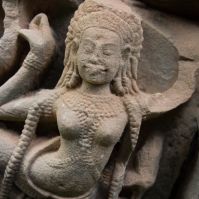
The German Angkor Imagery Project
• G • A • I • P •
Banteay Kdei is an impressive Buddhist temple complex in Angkor, Cambodia. It was built in the late 12th century during the reign of King Jayavarman VII and stands as a significant example of Khmer architecture. The name "Banteay Kdei" means "Citadel of Chambers," indicating its former use as a monastery.
The temple is surrounded by a double laterite wall enclosing a rectangular compound. The central complex consists of a series of galleries, courtyards, and shrines, connected by intricately carved gopuras (gatehouses). These gopuras are richly adorned with bas-reliefs depicting scenes from Hindu and Buddhist mythology, including representations of Apsaras (celestial dancers) and Devatas (divine guardians).
Banteay Kdei’s architecture reflects a blend of influences, integrating both Hindu and Buddhist elements. The main buildings are constructed from sandstone and exhibit remarkable detail in their stonework. Despite the passage of time and deterioration, many of the reliefs and structures remain well-preserved.
The temple is also known for its intimate atmosphere. Surrounded by a moat and lush vegetation, Banteay Kdei offers a peaceful and meditative environment. It is not only an architectural masterpiece but also a place of great spiritual and cultural significance, providing deep insights into the rich history and artistry of the Khmer Empire.
Banteay Kdei is renowned for its beautiful stone reliefs and depictions of female figures, particularly Devatas (divine female beings). These reliefs are of great art historical significance, offering a fascinating glimpse into the aesthetic and symbolic values of Khmer culture during Jayavarman VII’s reign in the late 12th century.
The female bas-reliefs in Banteay Kdei primarily depict Devatas, who serve as the temple’s guardians and celestial companions. These Devatas are masterfully carved into sandstone, characterized by their elegant and graceful appearance.
The Devatas typically stand in a frontal pose with heads slightly tilted, giving them a dignified and graceful presence. Often, one leg is slightly bent, adding dynamism and liveliness to the depiction.
The Devatas' hands are often depicted in symbolic gestures, known as mudras, frequently holding flowers or other religious symbols. Common mudras include the Vitarka Mudra, a gesture of teaching and discussion, and the Abhaya Mudra, a gesture of protection and fearlessness.
The Devatas wear intricately designed sarongs or wrap-around skirts, often adorned with fine patterns and ornaments. The fabric is meticulously detailed, with careful rendering of folds and textures.
The Devatas are richly adorned with jewelry, including necklaces, bracelets, armlets, belts, and headdresses. The jewelry is detailed and reflects the splendor and wealth of Khmer culture.
The Devatas' headdresses vary greatly, ranging from simple diadems to elaborate crowns decorated with lotus flowers and other symbols. These headdresses often feature intricate details that showcase the high craftsmanship of the time.
The faces of the Devatas are idealized, displaying an expression of inner peace and serenity. The features are symmetrical and harmonious, with gently smiling lips and almond-shaped eyes conveying a meditative expression.
The hairstyles of the Devatas are also intricately designed, often in complex braids or knots adorned with flowers and jewelry.
The depictions of the Devatas in Banteay Kdei are not only aesthetically pleasing but also carry deeper symbolic meanings. They embody ideals of beauty, virtue, and divine presence, serving as spiritual protectors of the temple. The presence of these female figures reflects the strong significance of femininity and divine beauty in Khmer religion and art.
The "Hall of Dancers" in the Banteay Kdei temple is another impressive structure within the temple complex, located in the central area of the temple.
The Hall of Dancers is a rectangular, open space supported by a series of columns. The walls of the hall are designed with many open passages and windows, allowing light and air to flow freely. The columns are intricately decorated with elaborate carvings depicting the dancers (Apsaras) after whom the hall is named.
The most striking feature of the hall is the numerous bas-reliefs that show the Apsaras in various dance poses. These celestial dancers are depicted with graceful movements, elegant garments, and ornate jewelry. The dances of the Apsaras were considered in Khmer culture as an expression of divine harmony and joy.
The dancers adorning the walls of the hall symbolize the spiritual significance of dance in Hindu and Buddhist culture. The dance of the Apsaras is seen as a connection between the earthly and divine worlds. The Hall of Dancers is a place where rituals and ceremonies were conducted.
The female bas-reliefs in Banteay Kdei are outstanding examples of Khmer art and offer valuable insights into the artistic and spiritual practices of the Angkor period. Their detailed and graceful depiction attests to the high regard Khmer culture had for divine female beings and the symbolic significance of beauty. These reliefs remain an impressive testament to the craftsmanship and cultural depth of ancient Cambodia.
• G • A • I • P •
Copyright © 2021 khmer-heritage.de